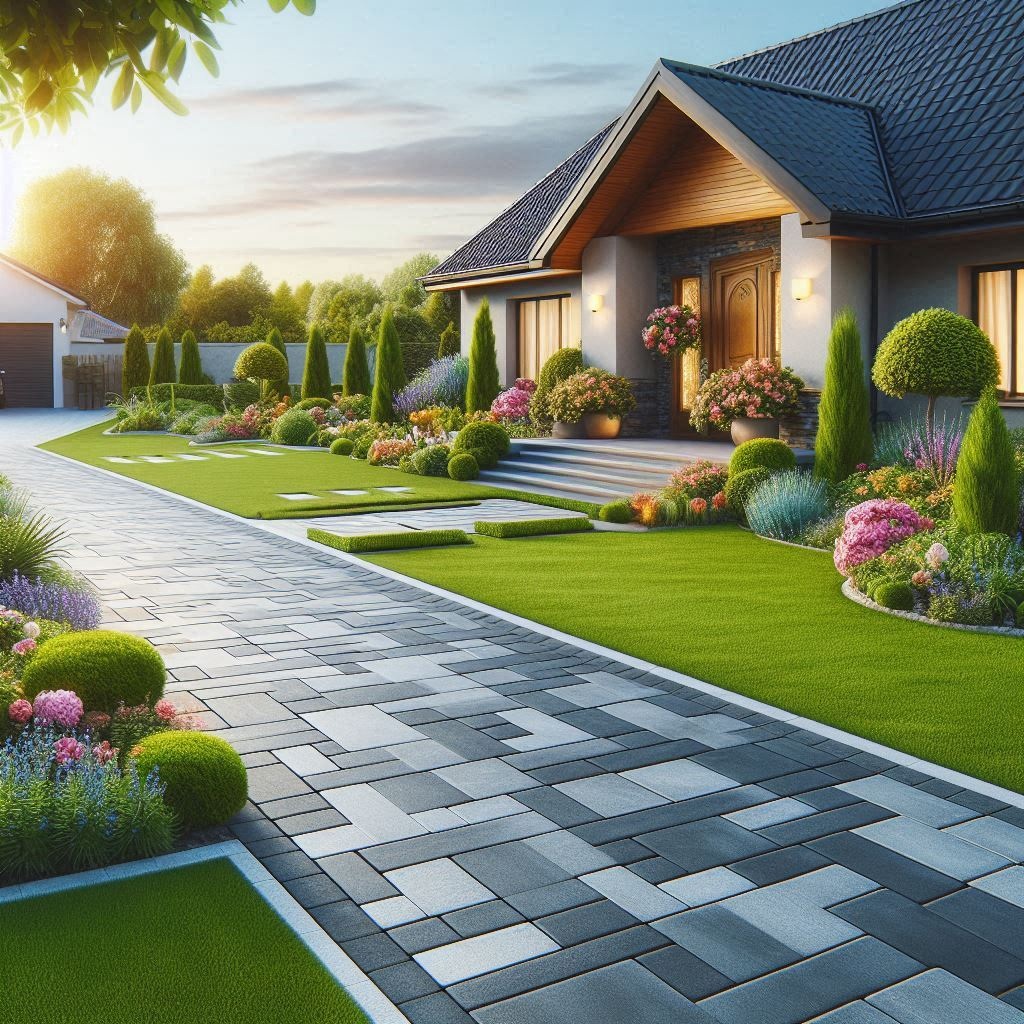
A well-designed driveway not only serves as a practical access point but also enhances your home’s overall appearance. Whether you’re looking to improve durability, aesthetics, or both, understanding your options, from materials and edging to site preparation and foundation work, is essential for a successful upgrade.
Material Options for Driveways
Concrete
Concrete driveways are popular for their durability and low maintenance. With a range of decorative finishes available, concrete can be stamped, stained, or polished to create unique patterns and textures, making it a versatile choice for many homeowners.
Cobblestone
Cobblestone driveways offer a timeless, classic appeal. Known for their longevity and robust character, cobblestones create a distinctive look. However, installation can be more complex and labor-intensive, so professional installation might be necessary.
Pebbles
A pebble driveway provides both aesthetic appeal and excellent drainage. The natural look of pebbles can complement a variety of landscaping styles. They are often used in combination with resin or sand to create a secure, attractive surface.
Asphalt
Asphalt driveways are favored for their smooth finish and relatively quick installation. They are especially popular in areas with fluctuating weather due to their ability to withstand temperature changes. Routine maintenance, such as sealcoating, is recommended to extend their lifespan.
Paving
Paved driveways offer immense design flexibility. Options include brick, natural stone, and interlocking pavers. Each material has its own benefits, from the rustic charm of natural stone to the clean lines of modern brick. Paving allows you to customize patterns and colors to match your home’s style.
Edging Options
The edging you choose can significantly influence the final appearance of your driveway.
Metal Edging
Metal edging provides a sleek, modern boundary that can be both durable and low-maintenance. It offers a crisp separation between your driveway and adjacent landscaping.
Stone or Brick Edging
For a more traditional look, stone or brick edging works beautifully with natural driveway materials. It creates a cohesive appearance and can add an extra layer of stability along the borders.
Plastic or Rubber Edging
If budget or flexibility is a priority, plastic or rubber edging is a viable option. These materials are easy to install and can adapt to curves and irregular shapes, although they might not offer the same longevity as metal or stone.
Site Preparation
Proper site preparation is critical to ensure the longevity and performance of your upgraded driveway.
Assessment
Begin by evaluating the current condition of your driveway. Look for issues with drainage, uneven surfaces, or underlying problems that might affect the new installation. A thorough assessment will inform your planning and material choices.
Excavation
Excavation involves removing existing materials and any debris to create a level base. This step is essential to prevent future settling and ensure that the new driveway remains even and stable over time.
Drainage Solutions
Effective drainage is vital to prevent water pooling and damage. Incorporate drainage solutions, such as slopes or channels, to guide water away from the driveway and foundation. Proper drainage not only extends the life of the driveway but also protects your home’s structure.
Foundation Materials
A solid foundation is the backbone of any durable driveway upgrade.
Sub-base Layers
The sub-base, typically made of crushed stone or gravel, provides stability and promotes proper drainage. This layer is essential in preventing the driveway from shifting or developing cracks over time.
Sand Layers
Adding a layer of sand on top of the sub-base can help with leveling and act as a cushion for the surface material. Sand aids in achieving a smooth, even finish before the final material is laid down.
Compaction
Compaction is a crucial step in foundation preparation. Ensuring that each layer is properly compacted helps eliminate voids and potential weak spots, ultimately contributing to the driveway’s durability and longevity.
Conclusion
Upgrading your driveway is a multifaceted project that involves careful consideration of materials, edging, site preparation, and foundation work. By selecting the right combination of options, you can create a driveway that not only stands the test of time but also significantly enhances the look and functionality of your home’s entrance. Whether you opt for the rugged charm of cobblestone, the modern appeal of concrete, or the versatile beauty of paving, a well-planned driveway upgrade will boost your home’s value and curbside allure.
And whether you’re considering a modest, cost-effective upgrade or a complete driveway overhaul, remember that you can post your job on our website and receive up to 4 quotes from paving contractors on Tradesmen.ie🙂
Cheers
Oliver Dempsey
Tradesmen.ie
3 April 2025
General Tips for hiring a tradesman
Here are some tips to consider when hiring a tradesman:-
1. Ask for phone numbers of references so that you can check them out
2. Check insurance of the tradesman where insurance is required
3. Hire a suitably qualified architect, building surveyor or building engineer if the job is anything to do with a new build, building renovation or extension
4. Agree on some sort of stage payments for the job. Remember that full payment should not be made until the job is complete and has been inspected by you, and if necessary by a certifier.






